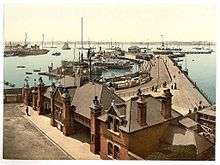Royal Pier, Southampton
Coordinates: 50°53′43″N 1°24′30″W / 50.89538°N 1.40831°W Royal Pier (previously called Victoria pier) is a derelict pier in Southampton, United Kingdom.[1]
The 900-foot (270 m) pier was opened on 8 July 1833 as Victoria pier and was built to provide steamer services with somewhere to dock.[1] [2] Prior to the construction of the pier steamer passengers had to either transit the muddy foreshore or make use of Town Quay which was already crowded with other commercial activities.[2] Prior attempts to fund a pier had been made in 1825 and 1828, and in November 1829 the harbour board agreed to construct one.[2] The act of parliament authorising the pier passed in 1831 and the construction was funded through a mortgage.[2] The pier was designed by Edward L Stephens a royal navy officer.[3]
In 1847 a horse-drawn tramway was constructed to link the pier to Southampton Terminus railway station.[1] In 1871 the tramway was extended to the end of the pier with a single platform station being built there.[1] In 1876 the trams switched from being horse-drawn to using light steam locomotives.[1] In 1888 the pier was given a new gatehouse.[1]

Over a two year period starting in 1891 the pier was rebuilt in iron and the station was expanded to house two platforms and the facilities to allow the pier to be used as a pleasure pier added.[1] These facilities included a pavilion.[1] The money for the pier's expansion came from part of a loan of £100,000 taken out by the harbour board which was also used to pay for dredging.[4] In 1894 the gatehouse was expanded and four years later a new pontoon was added to the pier enabling two steamers to be berthed simultaneously.[1] The addition of new pontoon coincided with the pier being renamed to Royal Pier.[1]
The start of World War I resulted in the suspension of tramway services to the station on the pier on 1 October 1914.[1] During the war the pier was damaged when a ship hit it.[1] This damage prevented the tram line from reopening at the end of the war and it was officially closed in 1921.[1]
The pavilion was enlarged in 1922 and the gatehouse was again rebuilt in 1930.During World War II the pier was closed to the public, re-opening in 1947.[1]
The pier was adapted to support RoRo ferries in the 1950s when Red Funnel introduced MV Carisbrooke Castle.[1] The pavilion underwent work to turn it into a ballroom in 1963.[1] The pier was closed at the end of 1979.[1]
The gatehouse was reopened as a restaurant in 1986 but a fire on 4 May 1987 destroyed many of the structures on the pier.[1] In 1992 another fire damaged the restaurant.[1] The restaurant reopened in 2008 serving Thai cuisine.[1]
References
- 1 2 3 4 5 6 7 8 9 10 11 12 13 14 15 16 17 18 19 20 Easdown, Martin; Sage, Linda (2011). Piers Of Hampshire & The Isle Of Wight. Amberley. pp. 70–77. ISBN 9781445603551.
- 1 2 3 4 Patterson, A. Temple (1966). A History of Southampton 1700–1914 Vol.I An Oligarchy in Decline 1700–1835. The University of Southampton. pp. 161–163.
- ↑ Patterson, A. Temple (1966). A History of Southampton 1700–1914 Vol.I An Oligarchy in Decline 1700–1835. The University of Southampton. p. 166.
- ↑ Patterson, A. Temple (1975). A History of Southampton 1700–1914 Vol.III Setbacks and recoveries 1868–1914. The University of Southampton. p. 69. ISBN 0854321462.